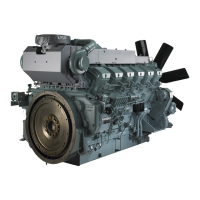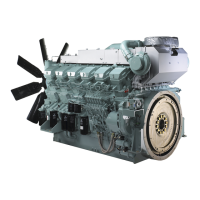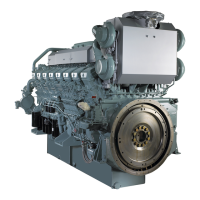Chapter 9 TROUBLESHOOTING
9-6
Engine Output is Low
Table 9-4 Engine output is low
Problem Cause Remedy
A
Engine emits
small amount of
exhaust.
(Engine output
and speed are
inadequate due
to insufficient
injected fuel.)
(1) Tendency of engine moving parts toward seizing
a Tendency toward seizing due to insuffi-
cient clearances of engine parts
Check abnormal heating of parts listed in
B-a in Table 9-3, and repair defective
parts.
b Inadequate lubrication
Check oil level, oil pressure and oil viscos-
ity, and add, adjust or replace oil, and also
clean lubricating system if there is oil clog-
ging.
(2) Insufficient amount of fuel supply
a Clogged fuel system or loose pipe Clean or replace. (Refer to A in Table 9-2.)
b Malfunction of fuel supply or injection
system
Clean or replace. (Refer to B in Table 9-2.)
B
Engine emits
excessive white
exhaust smoke.
(1) Engine knocking and excessive white smoke when engine is cold
Injection timing too advanced Correct. (Refer to C-(1) in Table 9-2.)
(2) Poor combustion due to low compression pressure
a Valve remaining open.
Check for valve, valve guide sticking and
valve clearances, and repair.
b Inlet/exhaust valve not contacting valve
seat properly
Disassemble and correct by lapping valve
in valve seat, or replace if necessary.
c Broken inlet/exhaust valve spring
Disassemble and repair, or replace if nec-
essary.
d Leaking of compression pressure due to
worn cylinders or sticking of piston rings.
Disassemble and repair, or replace if nec-
essary.
(3) Poor fuel condition (water in fuel)
Open drain cock and check fuel. Drain
water or change fuel.
C
Engine emits
excessive black
exhaust smoke.
(1) Fuel injection timing too retarded Correct. (Refer to C-(1) in Table 9-2.)
(2) Uneven fuel injection among cylinders
(Poor combustion condition, unstable rotation with knocking)
a One or more worn tappet rollers or cams
on camshaft in fuel injection pumps
causing deviation of fuel injection timing
Replace if worn.
b One or more plunger springs seized,
worn or broken
Disassemble, repair or replace.
(3) Poor spray condition of some fuel
injection nozzles
(Exhaust temperature of cylinders with
poor fuel spray condition may become
high.)
Refer to C-(2) in Table 9-2.
(4) Poor combustion due to insufficient inlet
a Malfunction of turbocharger (damage of
vanes, seizing of bearing, etc.)
Disassemble and repair, or replace if nec-
essary.
b Malfunction of inlet/exhaust valve Refer to B-(2) in Table 9-4.
c Air cleaner clogged with dust
Disassemble and clean, or replace if nec-
essary.

